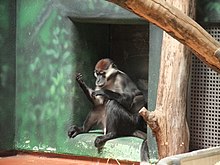Collared mangabey
| Collared mangabey[1] | |
|---|---|

| |
| Scientific classification | |
| Domain: | Eukaryota |
| Kingdom: | Animalia |
| Phylum: | Chordata |
| Class: | Mammalia |
| Order: | Primates |
| Suborder: | Haplorhini |
| Infraorder: | Simiiformes |
| Family: | Cercopithecidae |
| Genus: | Cercocebus |
| Species: | C. torquatus
|
| Binomial name | |
| Cercocebus torquatus (Kerr, 1792)
| |

| |
| Geographic range | |
The collared mangabey (Cercocebus torquatus), also known as the red-capped mangabey, or the white-collared mangabey[3] (leading to easy confusion with Cercocebus atys lunulatus), is a species of primate in the family Cercopithecidae of Old World monkeys. It formerly included the sooty mangabey as a subspecies. As presently defined, the collared mangabey is monotypic.[1]
Description
The collared mangabey has grey fur covering its body, but its common names refer to the colours on its head and neck.[4] Its prominent chestnut-red cap gives it the name red-capped, and its white collar gives it the names collared and white-collared.[4] Its ears are black and it has striking white eyelids, which is why some refer to it as the "four-eyed monkey".[4] It has a dark grey tail that exceeds the length of the body and is often held with the white tip over its head.[4] It has long molars and very large incisors.[5] The average body mass for captive individuals ranges from 9 to 10 kg (20 to 22 lb) for males and 7.5 to 8.6 kg (17 to 19 lb) for females.[5] Head-body length is 47–67 cm (19–26 in) in males and 45–60 cm (18–24 in) in females.[4]
Habitat and distribution
The collared mangabey is found in coastal, swamp, mangrove, and valley forests, from western Nigeria, east and south into Cameroon, and throughout Equatorial Guinea, and Gabon, and on the Gabon-Congo border by the Atlantic shore.[2][4]
Behavior
The collared mangabey lives in large groups of 10 to 35 individuals including several males.[4][6] Vocal communication in the form of cackles and barks are used to keep the group in contact and signal their position to other groups.[4] It has a diet of fruits and seeds, but also eats leaves, foliage, flowers, invertebrates, mushrooms, dung, and gum.[5][6] The collared mangabey has no defined breeding season, it reaches sexual maturity at five to seven years, and has an average gestation period of 170 days.[6]
Conservation status
The collared mangabey is listed as vulnerable on the IUCN Red List due to habitat loss and hunting for bushmeat.[2] It is also listed on Appendix II of CITES and on Class B of the African Convention on the Conservation of Nature and Natural Resources.[2]
References
- ^ a b Groves, C. P. (2005). Wilson, D. E.; Reeder, D. M. (eds.). Mammal Species of the World: A Taxonomic and Geographic Reference (3rd ed.). Baltimore: Johns Hopkins University Press. p. 154. ISBN 0-801-88221-4. OCLC 62265494.
- ^ a b c d Oates, J. F.; Gippoliti, S.; Groves, C. P. (2008). "Cercocebus torquatus". The IUCN Red List of Threatened Species. 2008. IUCN: e.T4201A10621068. doi:10.2305/IUCN.UK.2008.RLTS.T4201A10621068.en. Retrieved 11 January 2018.
{{cite journal}}: Unknown parameter|last-author-amp=ignored (|name-list-style=suggested) (help) - ^ Rowe, N. (1996). The Pictorial Guide to the Living Primates. Pogonia Press, Charlestown, Rhode Island. ISBN 0-9648825-0-7.
- ^ a b c d e f g h Matthew Richardson (26 March 2009). "Red-capped mangabey (Cercocebus torquatus)". ARKive. Retrieved 6 January 2012.
- ^ a b c The Primata (17 June 2007). "White-collared Mangabey (Cercocebus torquatus)". The Primata. Retrieved 6 January 2012.
- ^ a b c Nguyen, Khoa Huu (1999). "Cercocebus torquatus". Animal Diversity Web. Retrieved 6 January 2012.
External links
 Media related to Cercocebus torquatus at Wikimedia Commons
Media related to Cercocebus torquatus at Wikimedia Commons

